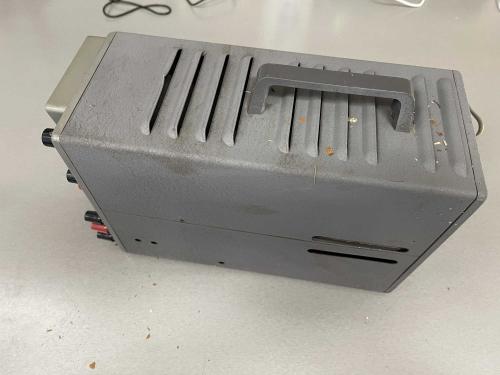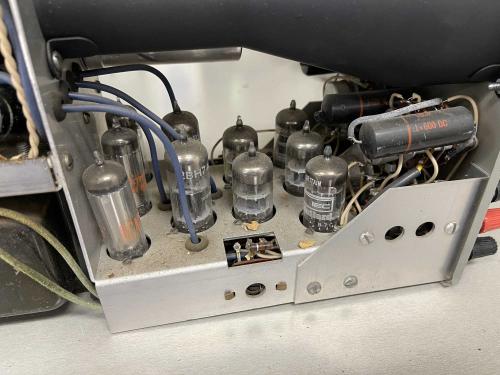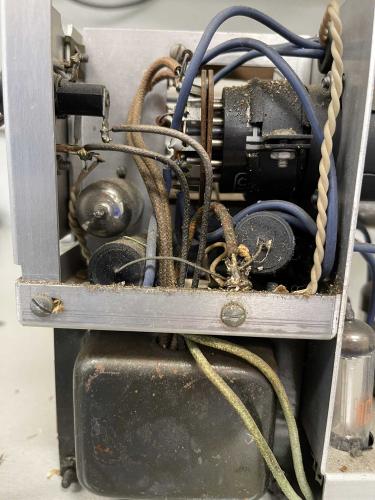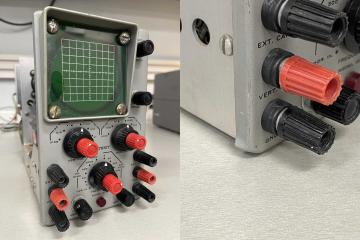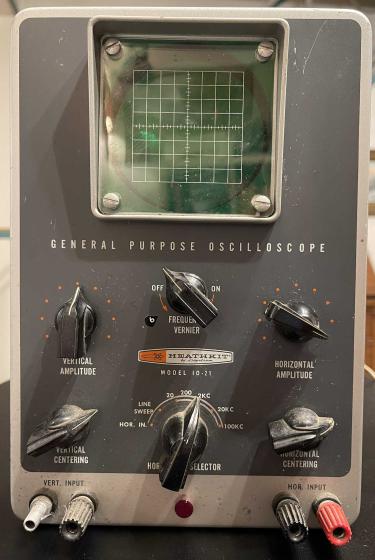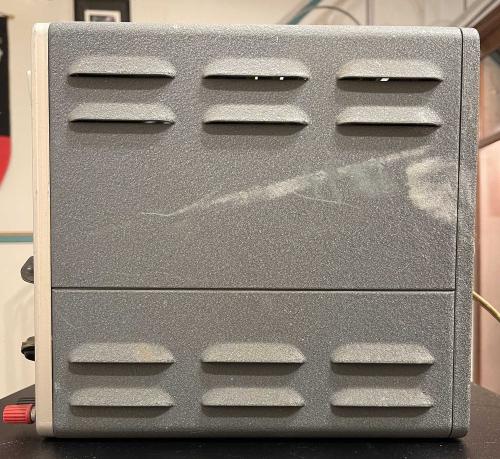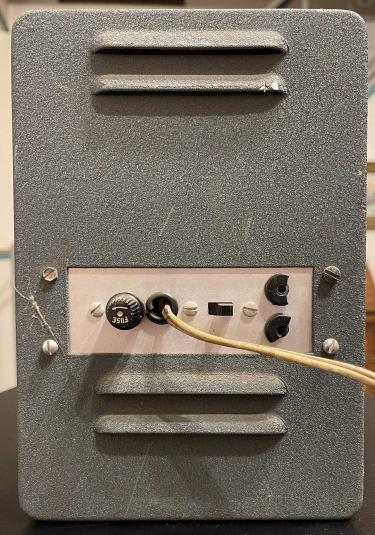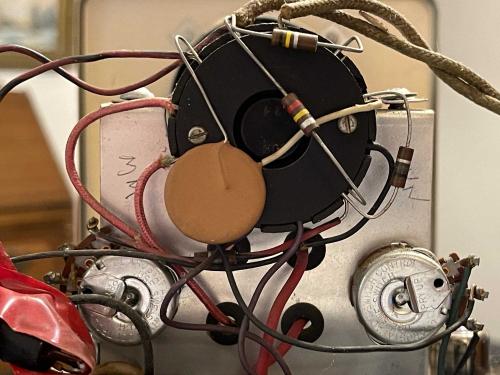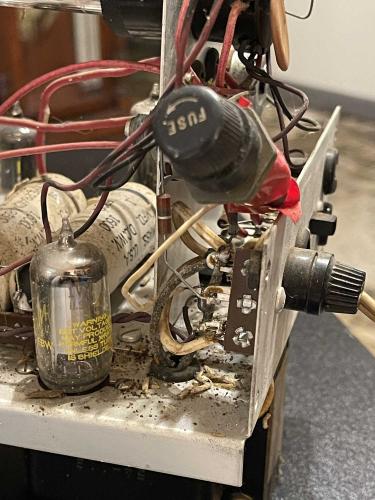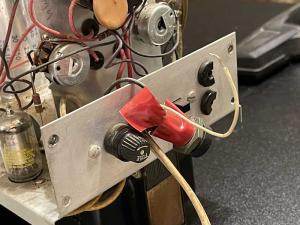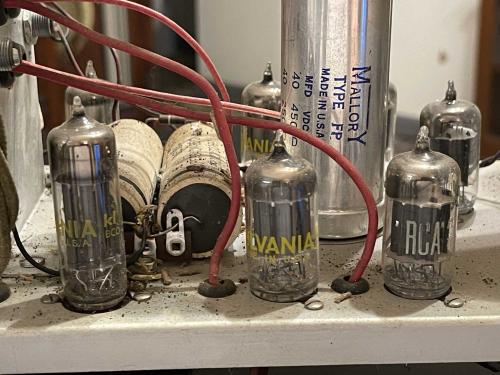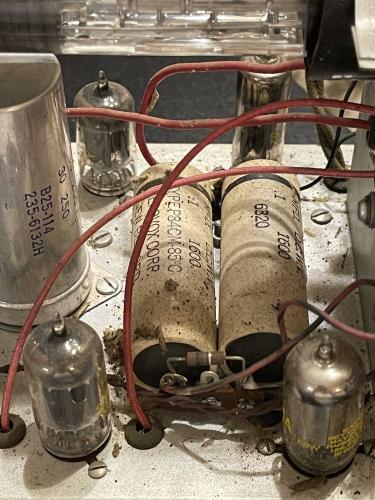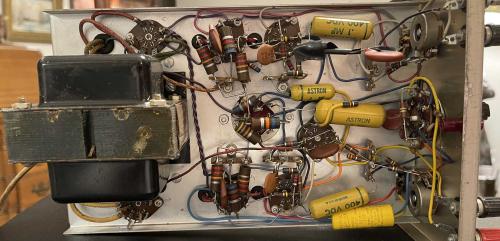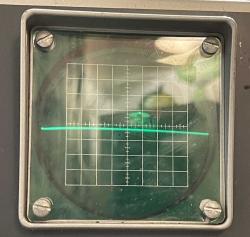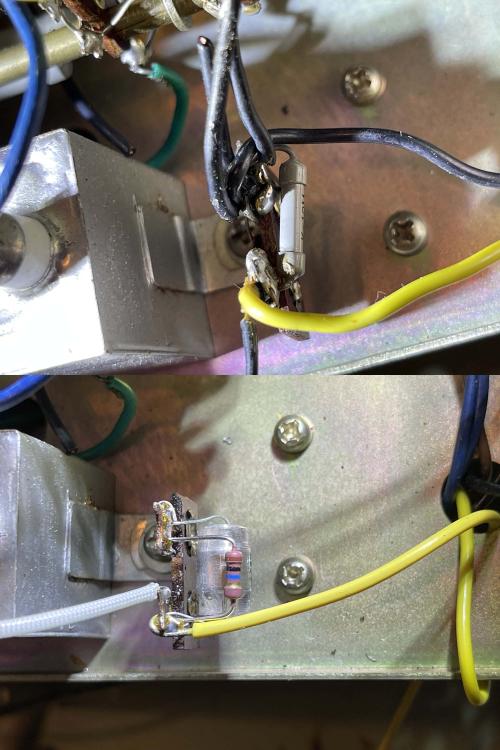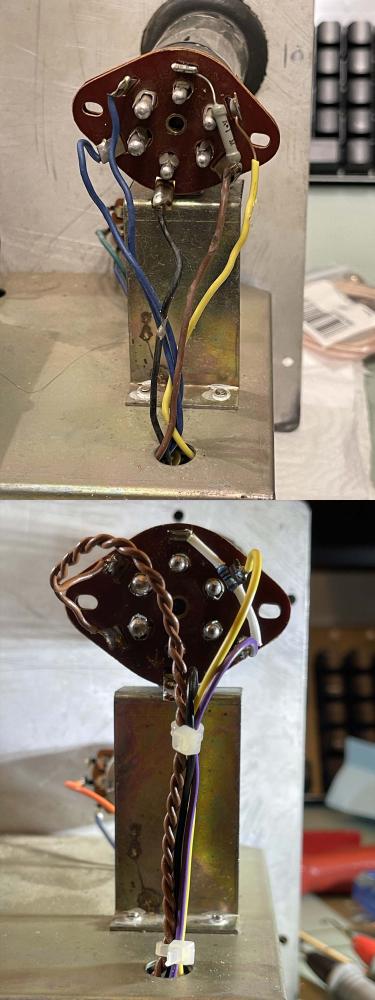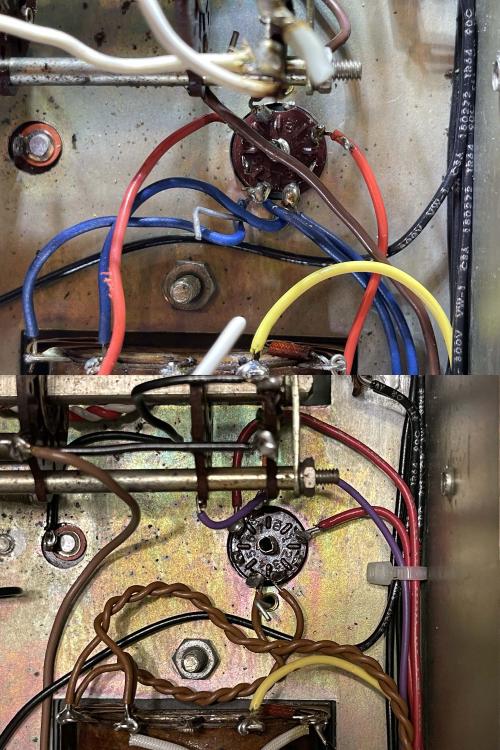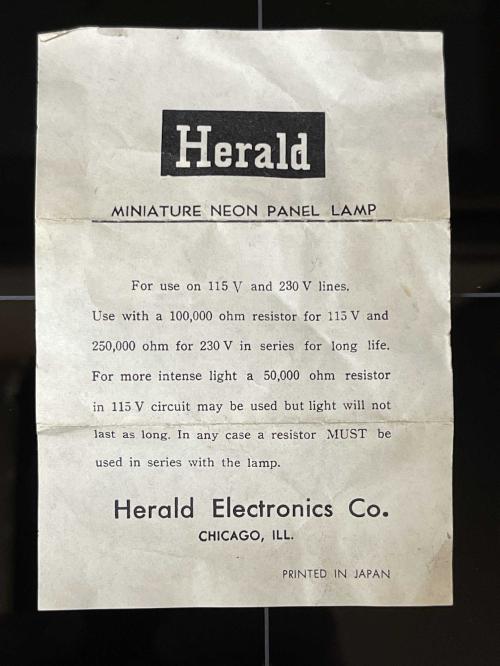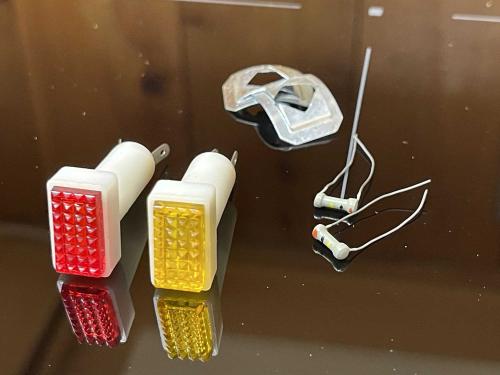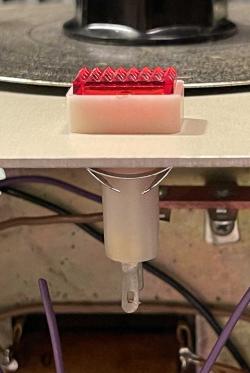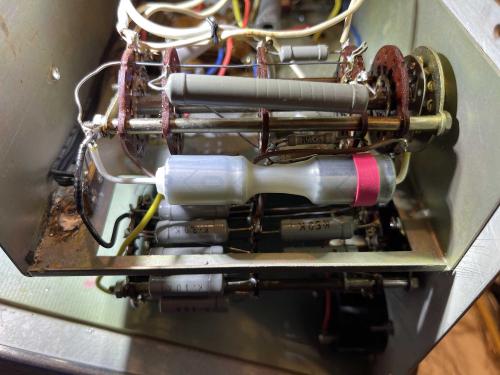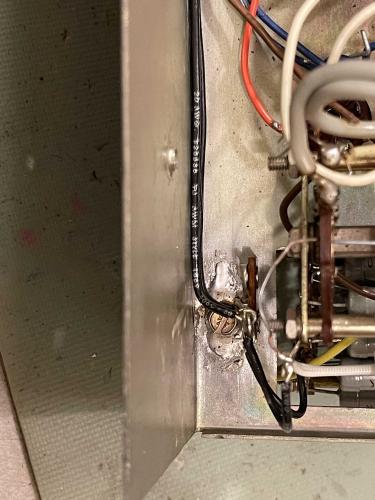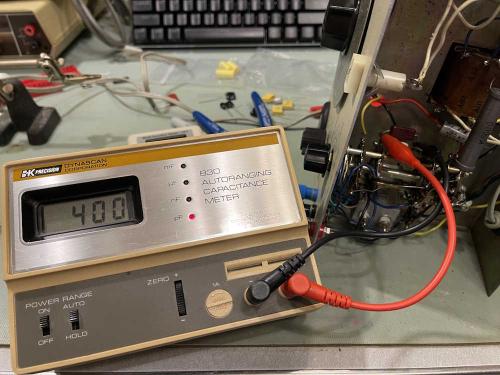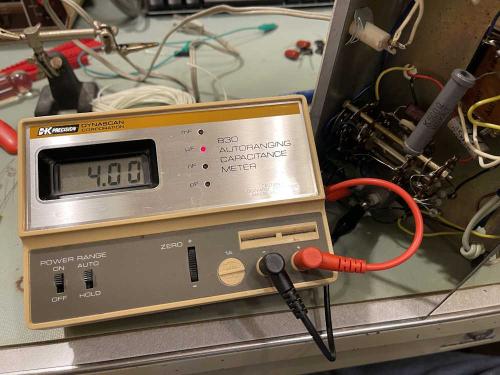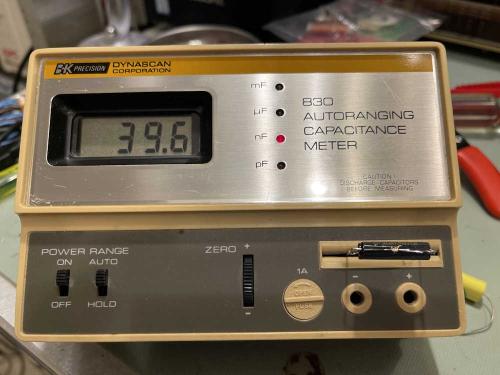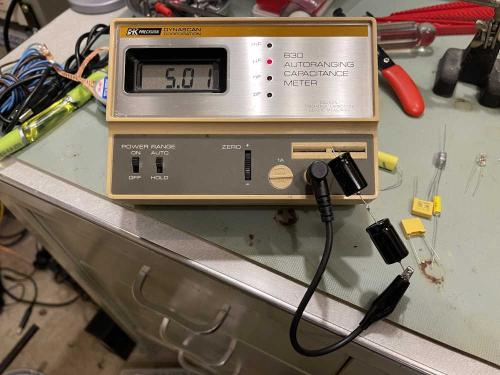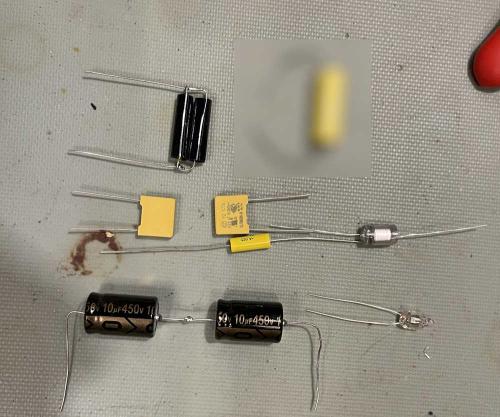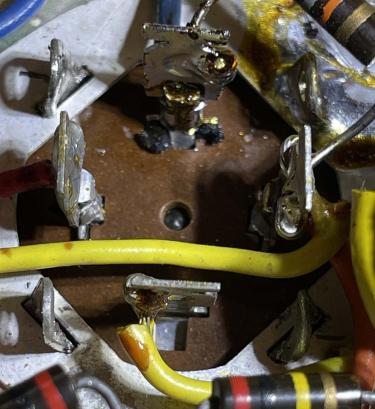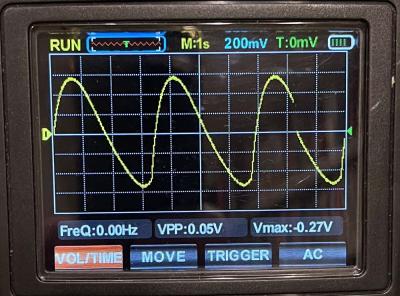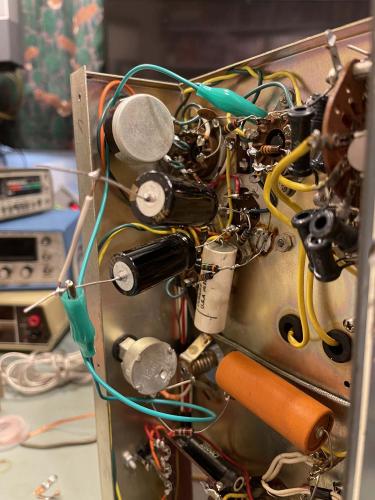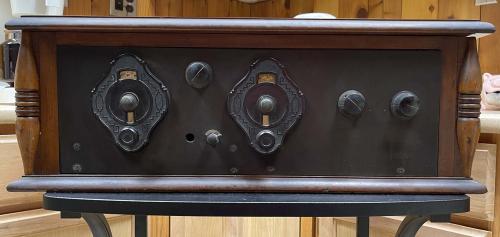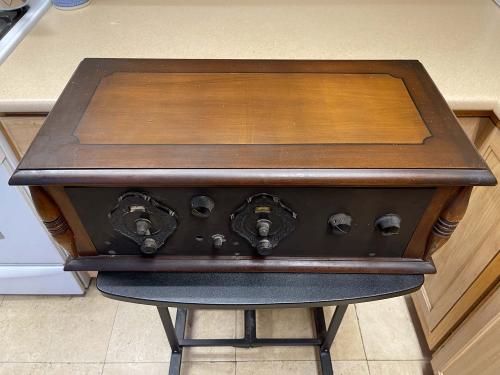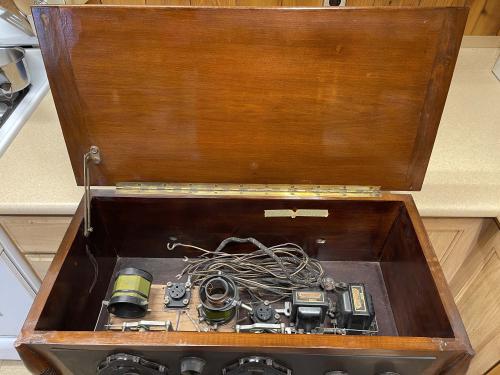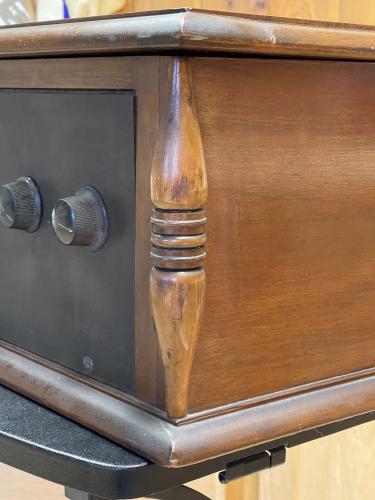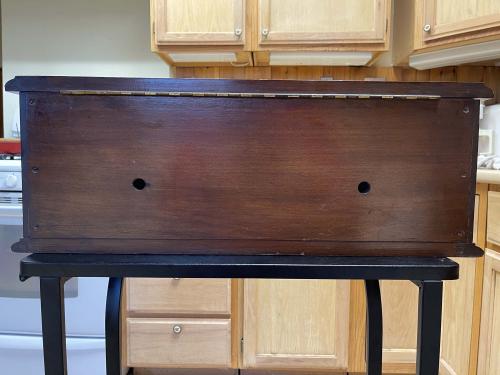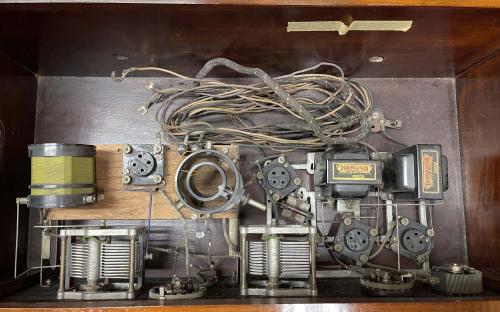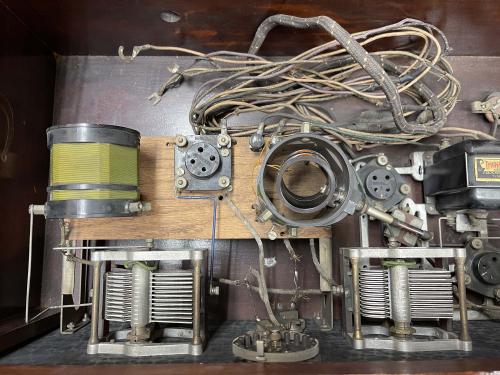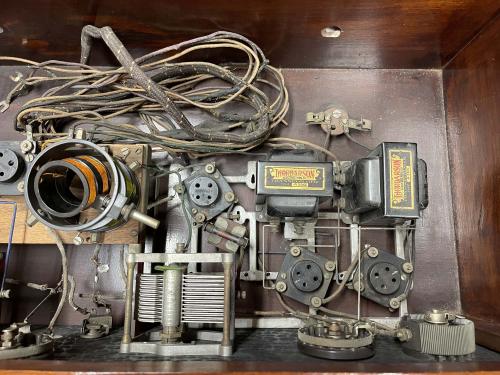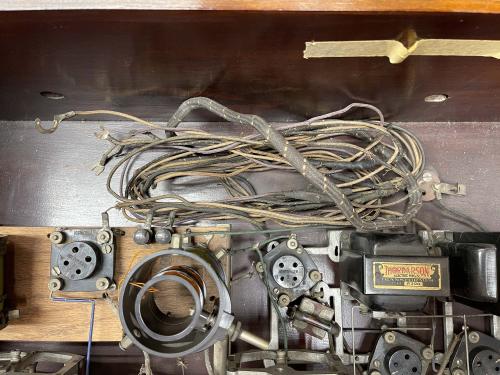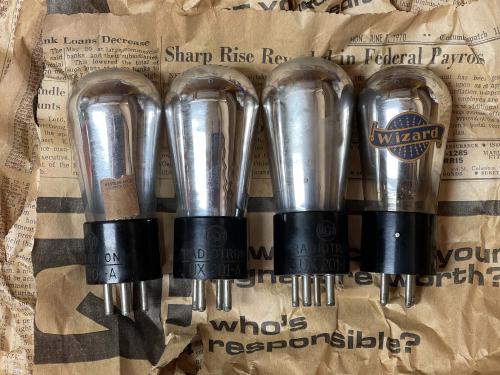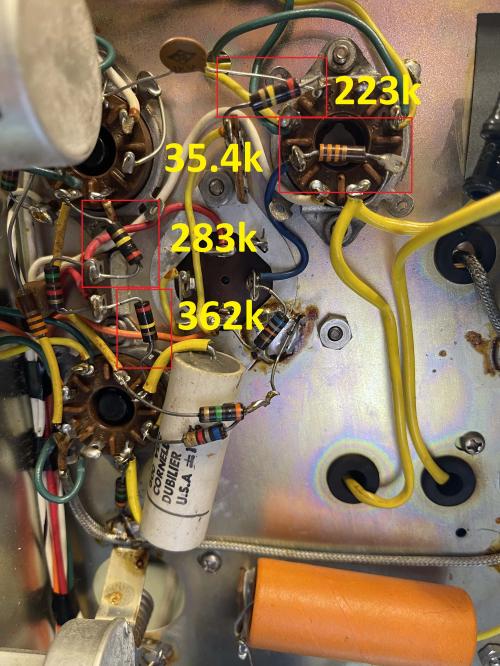- 2024
- Dec
- 13
The Heathkit IO-10 Oscilloscope - Part 1: Observations
In my quest to find a small bench scope, I picked up a couple of different models for a decent price. This IO-10 was a negotiated item - I mostly didn’t want to pay the asking price because it had a missing fuse holder cap, and that usually means that someone was working in the device trying to figure out why the fuse was blowing. Other than that, the device looked to be in pretty decent physical condition.
It arrived today in a box that, when new, was just a suggestion of cardboard and it didn’t really survive the trip. Uh oh. It was crushed somewhat and I expected the worst.
Opening revealed an apparently mostly intact device:
There was a lot of debris in the device. Paper, leaves, etc. I understand it had been sitting in a garage, but was it being used to shred leaves? Fortunately, all of the tubes are still in their sockets but you can tell they tried to vibrate loose. Most are the original Mullard, but there’s a couple of RCA, a Sylvania, and a GE device in here in the places you’d expect. Power supply, mostly. All covered with debris.
Most of the controls and one of the terminals are just frozen with goo and damp corrosion. This is going to need a good dousing with alcohol and tuner lube. I can’t even turn the power control. It’s locked.
Unfortunately, because it wasn’t packed properly, it got damaged at some point, probably dropped on it’s corner. I am sad because this thing was otherwise in 8/10 shape. I’m going to ask a friend who does metalwork for some advice on knocking this dent out.
It doesn’t appear to have been touched except for tubes, and the one part seems to indicate this was made sometime around 1968. So, it’s not terribly old - the electrolytics may be still good (but unlikely due to garage storage.) Everything else is disc, so this shouldn’t need much more than some good filter capacitors and maybe a few of those carbon resistors replaced.
This one is going to need to wait a while before I get it on the bench, as the holidays and some work-related items are going to take priority. Check back soon for more on this device!
Next part of this series: Coming Soon.
- 2024
- Dec
- 13
The Heathkit IO-21 Oscilloscope - Part 1: Observations
I’ve been wanting a small, AC powered oscilloscope for the bench, something that can do tube stuff without caring if you accidentally hit B+ for a second. Heathkit made several different styles that fit the bill, and I managed to run across this decent looking IO-21 3” scope for a reasonable amount.
It’s difficult to find one of these both in OK condition, and for a decent price. Like most items, people see “TOOOOB,” get some chatbot to write them garbage about how it’s a widely used accurate piece of equipment good for your toolbox, and slap a high price on it. It’s not, it’s something useful for a few of us, and the rest go and get one of those $60 Zotec Scopemeters for our toolbag.
Regardless, this is in ok shape. Most of the parts are there save for a terminal cap, which is no problem. I have many of those of the correct type from dead Heathkit devices of electronics past. It’s dirty, but that’s to be expected.
Note that many will label these as 10-21, but all scopes from Heathkit of this era were “IO” series.
The side
is a bit scruffy, and the back exhibits some broken plastic on the direct vertical inputs.
Those are just jacks, so they can be replaced if need be.
Time to take the back off…first impressions were this was built from a kit, and decently built.
But here’s a thing. The fuseholder was empty. That’s not a good sign, but here’s another fuseholder inside.
It’s not even really soldered, the one wire is just wrapped around the lower terminal of the mounted jack. Wut?
There’s a fuse in it, so I remove the extra fuseholder and put the fuse in the actual holder. Some have suggested that maybe someone was trying to parallel a fuse (maybe…) or didn’t have the correct physical size. Both are 3AG, so that’s not the case. I don’t know what was going on here, but hey - bonus fuseholder.
You’ll also note the large amount of insect debris here. That got a visit from Mister Shop Vac before proceeding.
The tube set is a mix of RCA made RCA branded, GE Made Sylvania Branded, and some washed tubes. This probably would have come with Mullard made Heath branded tubes, so this guy has seen a lot of use.
The ones in the back are 12AU7, but have nothing on them. No name, numbers, anything…chances are these came from a bulk reseller that would take used tubes, wash them of any marks, (maybe) test them and then (maybe) rebrand them as their own. That they work is amazing in itself.
Of note here is some capacitors used as filters for the CRT high voltage. 2x 1600V @ 0.01μF are prime candidates for being a Popping Patty, so they’ll need to go even if nothing else is wrong.
The bottom similarly reveals some capacitors that probably are going to need consideration, but overall it’s nicely built with just one add-in part that I assume was put there by someone other than the original builder.
Does it work? Some basic checks were made and I plugged it in. This device is a 6V parallel string for the tubes, and the 12AU7 are all folded over so they run on 6V. These tubes have their heaters split in the middle so you can operate on 12 or 6V, depending on your application. On almost all of them, only one side lit so a bit of wiggling later (dirty sockets) here comes a trace. It’s about as bright as it was when new, which is to say a bright room washes it out. But it’s there, and that’s the important thing - a dead CRT means a dead unit.
Stay tuned for the next part of this series, some cleanup and basic identification for parts that absolutely need to go.
Next part of this series: Coming soon.
- 2024
- Dec
- 11
An Olson TE-189 C-R Analyzer - Rebuild, part 2 - I only wanted to replace some capacitors.
After digging in to this unit, I determined that it was a basket case. While the unit itself wasn’t baked, the builder most certainly was. Probably less than 1 out of 5 wires in this thing (that weren’t bare interconnects on switches) was soldered securely. The rest? Bad or no solders, wires pulling out of their terminal, no wetting, too much solder, blobs everywhere. Burnt wires, solder drips…you name it. This thing was a how to on how to not solder. I realized that if I wanted to see this thing work reliably, it was going to be a partial rewire.
Here are some before and after shots of the cleanup crew’s work:
First is part of the drive for the eye tube. This consists of a capacitor coming in from the terminals on the front, a 1500pF capacitor, and a 10MΩ resistor on a terminal strip…with lots and lots of grounds attempting to terminate here as well.
All of the grounds were removed and single-pointed back to the other side of the chassis. The old parts were replaced with new, high quality parts - the input capacitor went from one of those leaky metal can Japanese parts to a new film cap, the 1500pF ceramic disk (with half it’s coating missing) is now a 600V polystyrene, and the resistor is just a good metal film part. The terminal is now clean with a single wire leading to it. Unfortunately, since the screw for this also holds the 4μF capacitor, I couldn’t solder it down, but it’s tight and clean.
Next is the socket for the eye tube. Almost every wire is burnt in some place, be it here or below the chassis. The black wire is j-hooked together, and the yellow wire has far more exposed copper than is safe. Even the 1MΩ resistor is poorly placed, having too much lead on one side and a “Oops, I cut it too short” lead on the other. Here it was just rewiring everything with fresh wire and properly twisting the filament leads. The resistor now lays in the socket with the proper spaghetti coating.
Last is the tube socket for the power supply. This has quite a bit of voltage on it, so it needed cleaned up. Twisted filaments, and fresh wire leading directly out of the socket fixed this one. I admit that the copper is a bit too much, but I’m happy with the results overall. The previous build had some solder balls here, and the fialments were all terminating to this point. I’ll brush this down to get the flux off before final inspection.
Prety much everything except for a couple pieces of coated wire and a couple of capacitors that are still good have been or are being replaced, including the big 500Ω balancing resistor that was flopping around the transformer. Even the AC has been moved off to it’s own isolated terminal strip for ease of disconnect in case of trouble.
I’m waiting on some Blue wire for the measurement section of the device (I’ve tried to keep the original color scheme as much as possible) so hopefully this will be done in a week or so. Stay tuned for the final part of the build, coming soon!
Next part of this series: https://wereboar.com … er-the-waiting-game/
Previous part of this series: https://wereboar.com … -intermission-parts/
- 2024
- Dec
- 11
The 1970s live in this Elenco M-1200 meter.
I didn’t need this device, but it came home with me as part of my “Can’t leave the hamfest without a voltmeter” program…It came from Fort Wayne and was a couple of bucks.
The real reason I picked this up is because of the design. This is so 1970s it hurts, although it probably was made in the 1980s. It’s a simple DMM and offers all of the things you’d need in a meter.
The device can run on batteries or external DC, as evidenced by the back. No mention of the required voltage, however, and the device is old enough that a headphone jack is used instead of coaxial for the power input. Since the device has 4x “C” cell as it’s internal supply, I’d assume the external power should also be 6V.
It’s woodgrain all around.
Inside, there’s not much. A power supply board with some circuitry for the meter, batteries, and the business end of the device (under the front panel.) Without the batteries, this thing would be quite light.
Here’s the main board. It’s most certainly an ICL7117 based device, as evidenced by the big DIP in the middle.
But does it work? I hooked it up to a nearby USB charger device, and it did read - although the decimal point was flaky. I had to wiggle the switch a little to get it to show up. (The 7117 is a simple 3 1/2 count ADC with 7 segment output. It’s up to the user to scale it and provide decimal points.) I didn’t check the unit for accuracy, just operation. I did notice a segment seems to come and go as well, so maybe some solder joints are cracked. Who knows.
What’s going to happen to this? If it’s accurate, it will probably go in my rack as a rail monitor. Otherwise, it’s just a cool piece of old tech.
- 2024
- Dec
- 10
An Olson TE-189 C-R Analyzer - Intermission: Parts
Almost all of the parts in the TE-189 C-R analyzer are available, save for the switches and the panel lamp. While the switches would essentially put the unit in the parts bin, other things like the panel lamp can be replaced with something else. It’s just a neon bulb in a package.
The one on my device was long since dead, so I tried to peel the case apart and replace the oddball neon bulb inside with something else. The case plastic was old and crumbly and that went about as well as you’d expect. It didn’t. On the off chance there was something similar out there, I did some searches and ran across the exact part on an auction site. And when I say “exact,” it’s OEM…
This is a pair of Herald Electronics miniature neon panel lamps. Herald Electronics of Chicago, originally called American Electronic Parts, was a sub-brand of Olson, and as such, one of their suppliers. Olson didn’t publish the fact that they owned this other brand, so Herald was apparently able to sell parts and supplies to other vendors for resale, without incurring the “We don’t want to buy from a competitor” thing you’d get by buying from your competition.
Herald, of course, sourced their product from various Japanese manufacturers, and vanished when Olson did. It was quite the surprise to find these parts, still new. I bought them right away. Here it is in the 1974 Olson Catalog:
There were 3 pieces for $2.19. Figure 14, part number PL-148J. Someone bought a set, used one, and put the rest in a drawer. Fortunate for me!
It came with the original pack-in paper pamphlet:
Interesting that the paper specifies a 100k resistor for longer life. The TE-189 has a 50k, so that probably didn’t help the lamp life. I replaced it with a 100k as specified.
The parts themselves are exactly what I needed, down to the little alignment tabs on the bottom. No surprise, they are the exact OEM part. I love the little dogbones they gave with the lamps.
And, of course, it fits in like it was made to be there. Here it is, waiting for wiring in to the panel.
I’m waiting for some wire and a new 500Ω power resistor. The mail is not cooperating right now, so stay tuned!
Next part of this series: https://wereboar.com … ace-some-capacitors/
Previous part of this series: https://wereboar.com … yzer-rebuild-part-1/
- 2024
- Dec
- 4
An Olson TE-189 C-R Analyzer - Rebuild, part 1.
SO…I thought that the TE-189 job would just be some tidy up and new capacitors. No, that’s not going to work. Turns out that the builder of this device (I hope this was a kit!) managed to get about 50% of the solder joints to hold. The rest were nothing more than burnt wire and insulation, badly wetted connections, and connections that were just kind of wrapped around one another and soldered with prayer.
I spent some time last night installing the new filter capacitor. Since a 5μF @ 700VDC is kind of hard to get at a reasonable price, I chose to use two 10μF @ 450VDC instead. These were connected in series to give the requisite capacity at 900VDC. I wrapped them in heatshrink and gave it a red band to identify the positive side of the device. That’s when I started to notice how badly the thing was wired.
You can see a brown wire attached to the same terminal as the positive side of the filter. This wire was just kind of stuck in the solder and came right off when I hit it with the iron. There was enough left that I could cut and strip and insert properly.
The grounds on this thing are a complete mess. A small terminal on the switch had multiple leads inserted in it - rather, attached to it. One was in it. One was wrapped on it. One just kind of hung there. A big blog of solder attempted to hold it all together. Grounds are flying everywhere in this thing instead of coming back to a single point. Plenty of other wires were the same with some just wrapped around other leads and soldered right into the insulation. Even the original filter was a wrap-job and wasn’t wetted properly.
How did this thing even work? Or did it? The neon bulb was dead so it spent some time on during it’s life…
I decided to solder a terminal strip directly to the chassis. Clean and wet the chassis and terminal, and hit it with the 80W iron. I know I’m talking about solder quality, but my 80W device is just not enough for this task. I’ll pick up something bigger this year. It did a (poor looking) job, so all grounds will now come back to this point.
There are around 10-ish ground connections going to all different places in the unit. I’m going to run them back to this double lug so they’re all at the same point. That involves removing a lot of other stuff, including jumpers across the transformer terminals, and a lot of stuff on the other side of the chassis. I’m going to run all of these and then slowly work my way across replacing wires that are in need of replacement. It’s going to be slow going.
Here’s an example of what I’m seeing - this is the ground for the 450-0-450 portion of the power supply. It was just kind of shoved through a terminal on the transformer and hit with some solder that didn’t really wet the lead. The across the line cap was then wrapped around the lead and soldered without removing any insulation - the capacitor just kind of melted into the plastic and didn’t really wet. It all goes away.
There’s a big lump of grounds just to the right of this that I’ll correct, and then start replacing capacitors and fixing the tube socket and the HV power supply.
Next part of this series: https://wereboar.com … -intermission-parts/
Previous part of this series: https://wereboar.com … yzer-considerations/
- 2024
- Dec
- 3
An Olson TE-189 C-R Analyzer - Considerations
I’m getting ready to replace some of the parts in this device, and I decided to take a look at what I’m doing and consider things.
I recently cleaned up an older B&K Capacitor Checker, and (in theory) this device should be a good reference instrument for measuring parts in this device. I decided to check things and it made me wonder if I really should replace all of them. There are some that will most certainly get a new part in their place, but others…
The first is the 400pF mica capacitor. I originally thought this thing was a mod, as it has a capacitor and a trimmer. However, I’ve seen another unit under rebuild and it has the same thing. The trimmer itself is plastic, so there’s no way this thing is approaching 600V, but it adjusted down perfectly and I had a good 400pF on the meter.
The big 4μF was similarly in good condition with this meter.
This one has good ESR and has a big 1k resistor to absorb the brunt of any voltage, so I think this and the 400pF will just be left alone for now. I have replacements in case they do need to go, but they don’t right now.
What does need to go is all of these metal can parts, especially the across the line capacitors and the filter. For the 40nF capacitor, I chose some 1% film parts at 630V and paralleled two of them for 40nF:
For the filter, two 10μF in series at 450V to make a 5μF at 900V. This part will probably get some heat shrink to strengthen the assembly. I chose this route because it was much cheaper than trying to find a part rated the appropriate voltage.
There are some resistors as well that seem out of tolerance, but those will need to wait. It’s not like this thing is going to be as accurate as a modern digital meter, but my concern was to prevent electrical problems.
The entire parts set to be replaced (save the 4μF):
1x 5μF filter capacitor assembly, electrolytic.
1x 40nF test capacitor assembly, film.
1x 0.01μF input blocking capacitor, film.
1x 1500pF capacitor for the eye, polystyrene.
2x 0.047μF across the line capacitors, safety film.
1x A1C neon bulb for the front panel.
Also, I am going to replace a poorly placed 1MΩ resistor across the eye tube, and perhaps the 1K and 500Ω resistors used in the test circuit (with the 500Ω just kind of hanging there in the air.) The latter two are both high-wattage parts (of unknown power) so a 10W part should be more than plenty on these.
That’s it for now - the next step is to put the parts in. That shouldn’t take long, but I’m also going to clean up some of the wiring as it’s in terrible shape. Stay tuned!
Next part of this series: https://wereboar.com … yzer-rebuild-part-1/
Previous part of this series: https://wereboar.com … some-notes-on-parts/
- 2024
- Dec
- 1
The B&W Model 200 Signal Generator Part 3 - setting it aside for now.
In the last part, I determined that the tubes (save perhaps the 6×5) were not at fault in causing this device to act up. After I wrote that post, I sat down with it just a bit more and did some poking.
First thing was to put a good 10k power resistor in place of the one that rose to 160k when warm. No change in operation. Second was to give it a good look-over one more time.
I noticed that there was some goo coming out of the electrolytic in the oscillator section. That’s not good.
Ok, so that capacitor is probably bad. I measured the DC voltage on it.
There’s a really slow variation in the DC that matches the oscillator’s on-off cycle. I did some quick bypass with new caps, paralleling the presumed bad devices:
No change.
This thing has more problems than I originally assumed, and the lack of any information on the unit is hampering my ability to work with it.
For the time being, this goes back on the “needs work” shelf, as I already have a working generator and need to get some other devices fixed. If I can get to it before Hamvention, then I’ll take another look. Stay tuned!
Next part of this series: Coming sometime maybe.
Previous part of this series: https://wereboar.com … or-part-2-diagnosis/
- 2024
- Dec
- 1
An Unknown 2-dial TRF radio.
The Scott Antique Market happened this weekend, and much to our (and a lot of other people’s surprise!) it opened an hour later at 9AM. Remember what I said about checking hours? Well…guess what this stupid little pig didn’t do?
(Some update notes on this - it could be a regen unit as well, according to some. The little glass part marked “GLASTOR” may be a grid-leak resistor, aka GLASs resisTOR. And, there are no parts under the wooden plate. What you see is what you get!)
Anyway, there was some good stuff to see, but I didn’t really see anything I wanted to bring home until we were getting ready to head out. My show-going companion stopped by a big coffin set on a table. The guy had a price on it and I was going “That’s a good price for that piece.” I ended up buying a box of tubes he had beside it, but my buddy was stuck on the radio set itself. I looked, hmmm’d…do I have room for this thing. The guy said “If you want this, how about this other, lower price.” Buddy was just looking at me with puppy dog eyes saying get this dude. So I did.
It’s obviously a homebrew set. The empty hole doesn’t look like anything was ever in it.
Two tuning capacitors, a couple of rheostats, and an on-off switch adorn the front.
The cabinet itself is pretty good outside. A little scuff here and there and some paint splatter - but considering this thing is probably nearing 100 years old, it’s a solid external 7/10. Inside is very clean, and probably resembles the day it was built. There’s some cloth loss on the wiring, of course, but that’s acceptable and understandable. Some things will need to be tightened up - the escutcheon dials are loose - but nothing major.
Similarly, the rest of the case is in good condition. The varnish on the top is really the only bad spot on the unit.
As for the inside…it’s your standard TRF layout. Two tuning capacitors and a tuned inductor present themselves immediately. I’m not really that familiar with TRF sets, so I’m not going to go any further with that in trying to define what they all do. Four tubes, and two interstage Thordarson R200 transformers are really all that’s in this thing. I’m assuming there are some parts underneath the wood plate, but I have not dug that far into the unit.
I’m going to assume this needs +90, +22.5, +5, and +1.5, and that they went in the spot where the cables currently reside.
As for the tubes, all of them were present but wrapped in paper, so I don’t know where they go.
Tube compliment for this is 3x UX201A and 1UX200A. The 201’s are all RCA branded, and one has a Western Auto Supply price tag of $5.00 on it - that’s nearly $91 today! The final UX200A is unbranded on the base, but has a “Wizard” sticker on it. It’s also priced at $5.00 at Western Auto - so there’s nearly $400 in tubes in this thing!
The 200A dates this to at least 1926 and no earlier, as that device was introduced in May 1926. It’s possible the unit is older, but I can’t see someone discarding such an expensive tube just because a slightly better model was announced (although it’s possible.) Since superheterodyne was already a thing at the time, it’s probably not much newer than ‘26 as TRF was a rather poor (although easy) way of getting audio from the air.
The paper the tubes was wrapped in is a Columbus (Ohio) Dispatch from 1970, so the previous owner set it aside some 40 years after it was turned on. The paper itself is quite interesting - a story about how banks are cutting back on loans, a story about how federal payrolls are ballooning, and an ad for credit card fraud monitoring and restoration. You could almost change the date and reprint this thing!
Regardless, this was a great deal and I’m happy I brought it home. As stated earlier, TRF is really outside my knowledge range, so my next step is to grab a few early radio books that have TRF circuits in them. It’s quite likely that the original builder followed a schematic in a book or magazine, so finding something similar probably won’t be too difficult.
If you recognize the layout please let me know on Mastodon or LinkedIn, and stay tuned!
Next part of this series: https://wereboar.com … fying-things-inside/
- 2024
- Nov
- 27
The B&W Model 200 Signal Generator Part 2 - Diagnosis
As seen in the last part of this series, there’s definitely a problem in this unit preventing it from oscillating properly. It’s time to start digging in and seeing what’s what.
I picked up a new / tested good used set of tubes at the recent Fort Wayne Hamfest. I started with a baseline measurement to make sure everything was acting as before, and then started with the rectifier. The signal output was a big stronger, so the 6X5 is probably weak. Not a big deal, and probably expected.
Going around the rest, including the PTC resistor lightbulb, nothing changed save the signal was again a little stronger with a new 6SJ7 oscillator tube. Not enough to worry about, so all tubes were swapped back to the originals. The problem is in the components.
The device is mostly disc capacitors, and while they do go bad, it’s not often. Ignoring those for now, I decided to do a quick check to spot any obvious failures before powering and measuring voltages. First thing I checked was the big 10k 2W that I assume is a power supply divider.
160k and dropping. Odd…no capacitors here, and it finally settled down to 9.91k. That’s probably the smoking gun right there - the resistor is changing value as it gets hot and driving B+ down to a level where the unit can’t oscillate. Once the oscillator is off and the current is lower, the B+ increases just enough to oscillate - rinse and repeat. I need to check B+ to make sure, but this sure is suspicious.
With a reasonable guess secured, I did some spot checks around the oscillator. There’s a 33k across the 6SJ7 that has increased to 35.4k - a little out of tolerance but eh…there’s also a 200k flying off the tube, and it was quite high at 223k. Ok, that’s possibly a problem. I noticed two more of this type and checked those - way way out of tolerance. Everything else seemed to be close enough that I wasn’t concerned,
I wonder what made just those particular ones that bad?
There’s a couple of other things here that probably should go. That big white CDE El-Menco ripoff capacitor is a type that can be problematic. There’s also a dry electrolytic that’s checking fine but probably can go, and a black plastic capacitor that connects to the output control that needs to be replaced because they crack and gain moisture.
There are multiple supply electrolytics, and they all seem to be good. I’ll need to let the unit run a bit and see if they get warm, but if not then I’m not going to worry about them until something happens. I’m going to replace that nasty power cord as well, but that’s just a “always do it” thing for me.
With possible fixes identified, it’s time to set this unit aside until parts arrive. Stay tuned!
Next part of this series: https://wereboar.com … ng-it-aside-for-now/
Previous part of this series: https://wereboar.com … 00-signal-generator/
